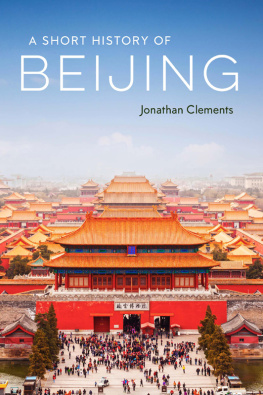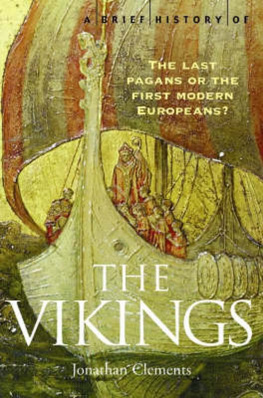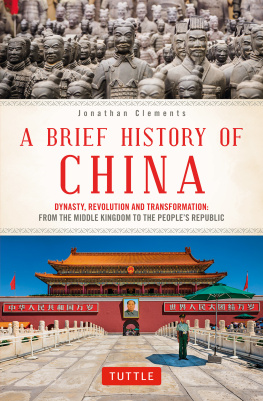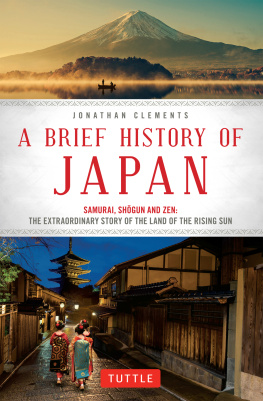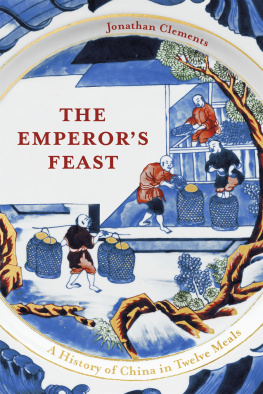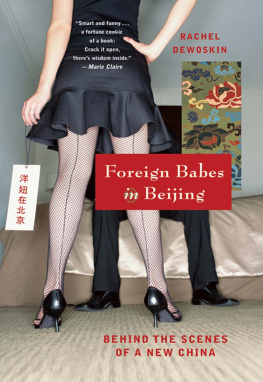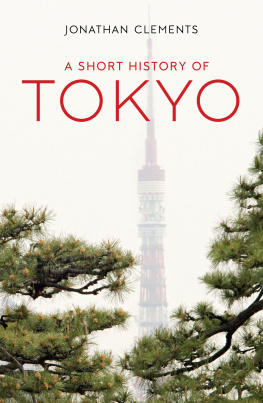Contents
Pagebreaks of the print version
A Short History of Beijing
JONATHAN CLEMENTS is a historian specialising in East Asia. His books include A Brief History of China, The Art of War: A New Translation, The Emperors Feast: A History of China in Twelve Meals and biographies of Chairman Mao, Marco Polo, Khubilai Khan and the statesman and explorer Gustaf Mannerheim. His biographies of Empress Wu and the First Emperor of China and his history of the Silk Road have been translated into Chinese. He has appeared as an expert on Asian history in episodes of the TV programmes Secret History and Nova. For the National Geographic channel, he has presented several seasons of Route Awakening, a TV series on the historical origins of Chinese cultural icons, as well as the documentary Shandong: Land of Confucius.
PRAISE FOR THE FIRST EDITION, AN
ARMCHAIR TRAVELLERS HISTORY OF BEIJING
This book is like having a friendly, knowledgeable companion taking your arm as you wander through the back alleys and boulevards of one of the worlds great cities. Clements wears his learning lightly, and his informed but inclusive tone makes this the perfect book for the visitor to Beijing. Rana Mitter, author of Modern China: A Very Short Introduction
Beijingers, both Chinese and foreign, mourn the Chinese capitals rapidly disappearing traditional alleys, but few of us appreciate Beijing as a city that has lasted through 2,500 years of building and destruction. Jonathan Clements tour of the city starts with Peking Man and a jovial candy seller, and moves on through the Chinese dynasties with a readable flair. He comes well-stocked with tales that will be new even to long-time residents. Its a book for a warm tea-house on a cold winter afternoon. Lucy Hornby, Former China correspondent, Financial Times
Its hard to imagine anyone better equipped than Clements to compile a readable account of Beijing. Authoritative yet deliciously irreverent, his history of the city is an essential companion for the visitor and a treasure trove of vicarious delights for the chair-bound. John Keay, author of China: A History
If New York and London dominated the global imagination in the twentieth century, Beijing is already in the process of usurping them in the twenty-first. An extraordinarily exciting city, possessed of enormous optimism and expectation, it has a long, fascinating and complex history. Jonathan Clements peels the onion that is Beijing and, in a highly readable and informative book, gives us a wonderful glimpse of the history of a compelling city. Martin Jacques, author of When China Rules the World
A direct, well-written history that travels at a steady pace from Peking Man to the ill-fated opening of a Starbucks inside the Forbidden City If youre after some interesting facts to impress friends and visitors with, this is the book for you. Thats Beijing
Jonathan Clements evocatively captures the contradictions and complexities of contemporary Beijing while rooting the city in its broader historical context Covering such a wide swathe of territory is no easy task, but Clements does so skilfully and often wittily, weaving together myth, factual data and vivid details. Times Literary Supplement
A Short History of Beijing
Jonathan Clements

First published in Great Britain in 2016 as
An Armchair Travellers History of Beijing by
The Armchair Traveller
4 Cinnamon Row, London SW11 3TW
This first paperback edition published in 2022 by Haus Publishing Ltd
Copyright Jonathan Clements, 2016, 2022
Some parts of this book also previously appeared in Beijing: Biography of a City (Sutton Publishing, 2008)
Map on p. ix created by Martin Stiff
The right of the author to be identified as the author of this work has been asserted in accordance with the Copyright, Designs and Patents Act, 1988
A CIP catalogue record for this book is available from the British Library
ISBN: 978-1-913368-46-3
eISBN: 978-1-913368-47-0
Typeset in Garamond by MacGuru Ltd
Printed in the United Kingdom by Clays Ltd (Elcograf S.p.A.)
All rights reserved
For Julie Makinen
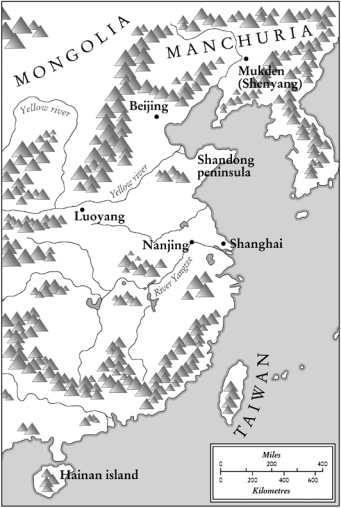

Acknowledgements
P arts of this book previously appeared in a substantially different form as Beijing: The Biography of a City (Sutton Publishing, 2008). Neither subject nor author was the same eight years later, when this book appeared in hard-back, or six years after that for this paperback edition. The volume you are reading draws on much new development in Chinas capital, particularly the growth of its subway from a mere two lines on my first visit to todays twenty-four, and the new ease this affords the tourist for getting around. Professor Li Qi, of Xian Jiaotong University, made my visits to China much easier by appointing me a visiting professor from 2013 to 2019. For Beijing itself, advice and hints were at hand from Alicia Noel, Chris and Randa Westland, Wang Xueer and Qiao Zhilin, who so sweetly trawled second-hand bookshops in search of a copy of the Lao Beijing Lxing Zhinan. I also gratefully acknowledge the work of Ran and Hat600 for their efforts not only in compiling an up-to-date English-language subway map but in making it available under a creative commons licence.
Julie Makinen and her sometime flatmate Lillian Chou were welcoming hosts in the diplomatic quarter, introducing me to the joys of Little Moscow, the Central Business District and the hippest of hipster hutongs. Louisa Lim and Amy Li Xuebai invited me to their restaurants, Southern Barbarian (Yunnan food, now sadly gone) and Pak Pak (Thai food, still clinging on after COVID-19), and discussed the intricacies of running a business in Beijing skulduggery, bribes, double-crosses and all. On many occasions, I have been accompanied by friends, relatives and colleagues, whose whims and caprices have often dragged me to places I would not have otherwise been: Emily Carlson; Kati Clements; Andrew Deacon; Philipp and Sara Holtkamp; Raija, Matias, Timo and Seija MkiKuutti; Henri Pirkkalainen; and Tino Warinowski. My son Alexander spent much of his early life in China and was never a burden on explorations of the city together, leading me into many new and unexpected encounters, including the time he was savaged by a rabbit at the zoo and the time he decided to rush the security fence at Maos mausoleum.
Introduction
W angfujing, the best-known shopping street in Beijing, is wide and pedestrianised, dotted with interactive sculptures of merchants, artisans and musicians. It is the only street in the world where a visitor can get their watch fixed (at the Hengdeli watchmakers), dine on Beijing duck and/or a scorpion kebab, shop for nappies in the Childrens Store, and bungee-jump from the roof of the Lisheng sports store.
Despite its sanitised, modern appearance, and its thick cluster of shopping malls, Wangfujing is steeped in history. The street boasts two museums, unnoticed by the casual stroller: an archaeological exhibition of Palaeolithic hunters, hidden inside the Oriental Plaza mall, and the Beijing Arts and Crafts Museum, tucked away on the fourth floor of an unassuming shop.

